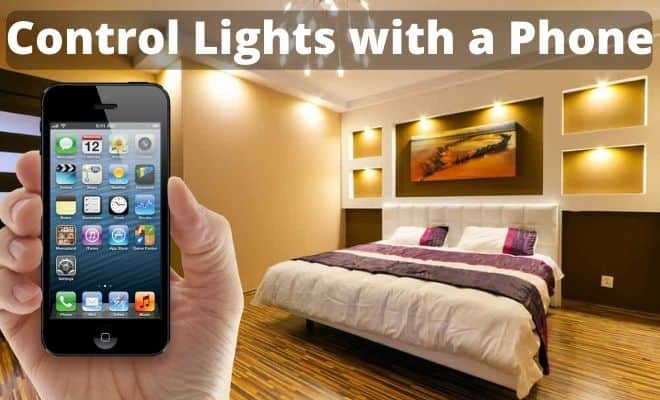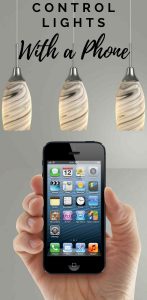Last Updated on December 16, 2020 by The Tutor
How to Control Lights With a Phone

Homeowners who want to look into smart home technology often begin with learning how to control lights with a phone. Using proper lighting brings a homey ambiance to any home. Home lighting technology has greatly evolved throughout the years from using simple incandescent light bulbs, to upgrading into cost-effective LED lights, to converting into smart lighting that can be controlled by your smartphone.
Using smart lights usually jumpstart the conversion of an ordinary home into a smart home. One of the advantages of using smart lights is that you can control them remotely using your smartphone and a mobile app. It allows you to make lighting adjustments based on room occupancy, the time of the day, and other specific conditions you set.
How to Control Lights with a Phone
You can control the lights in your home from anywhere in the world with your smart phone by installing a compatible app on your phone which speaks to your home network to control your smart light bulbs, switches, outlets or light fixtures.
Your smart phone will direct your wifi network or hub to send a signal to the smart light bulbs or smart devices to turn on, off or perform any other task such as dimming or even changing colors. One major advantage of this technology is the ability to communicate to your lighting devices from anywhere in the world.
Here are three important things you need to know to control lights with a phone:
1.You need a platform to control smart lights
Before buying smart lights for your home, you first need to decide which platform you want to use to control them. There are platforms that offer control apps that allow you to group lights together and create a schedule for them to turn on and off at specific times, based on your lifestyle and needs. There are also platforms that let you control all the other smart devices in your house. You can also pair your smart lights with voice assistants, such as Google Assistant, Apple’s Siri, or Amazon’s Alexa.
2.You may need a hub
Smart lights use wireless transmissions to send and receive their signals. Depending on the type of smart light bulbs you use different, you will need different methods to control them. Some smart lights use built-in WiFi to connect directly with your router. This allows you to control them remotely from your phone as long as you have an internet connection.
Other smart lights use Bluetooth to connect to your phone so you can control them within 50 feet or more. These types of smart lights need a hub to relay their signals so they can be controlled remotely.
Some smart lighting products use ZigBee, a local wireless network for smart devices, to send their signals. ZigBee smart lights also need a ZigBee hub plugged into your router to translate those signals for your home network. Most ZigBee light bulbs come with their own version of a hub that you can set up on your own.
3.You may need a mobile app to control your smart lights
One of the advantages of smart lighting is that you can control them remotely using your mobile device. To be able to do this, you need to have a mobile app that allows you to control your smart devices, including your smart lights. There are two types of home automation mobile apps available: the single-tasking app and the multitasking app.
Single-tasking apps are only made for one specific device — for example, you can use a single-tasking app to only control your smart lights. Single-tasking apps cannot be used to operate any other smart things in your home. A multitasking app can help you to control the entire IoT system installed in your home. You can use this type of app to operate all of your smart devices.
Types of Smart Lighting Technology 
The smart lighting system starts with your phone and and allows homeowners to control and adjust their home lighting through their home network with a phone. The use of smart lighting offers many benefits, including user convenience, long-term savings on electricity, and accessibility.
The most important component of a smart lighting system is its smart lighting technology, which allows the smart lights to connect to the internet so they can be controlled remotely. Here are a few of the most common smart lighting technologies used in many smart homes:
- A smart lighting system that connects to WiFi: These are WiFi-based smart lights that use WiFi routers to connect to the internet so they can be controlled remotely. WiFi-connected smart lighting systems cannot work remotely if they are not connected to the internet.
- A smart lighting system that connects through Bluetooth: Bluetooth-based smart lights can be operated locally using BLE-enabled smartphones. A Bluetooth hub, which is used to connect devices to the internet, is needed for Bluetooth-based smart lights to be controlled remotely.
- A smart lighting system that connects to ZigBee or Z-Wave: Smart lights that are connected to a ZigBee or Z-wave work like Bluetooth-based smart lights because they create a mesh network but cannot be operated remotely without a hub. You need a hub to be able to control ZigBee and Z-Wave smart lights.
Available Apps That Control Lights with a Phone
You can use either a single-tasking app or a multitasking app to control your smart lights. Here are a few examples of apps available in the market today:
- Smartlife App: The Smartlife app is our personal favorite because it is a generic app that you can use to control many different types of devices including lights, switches, plugs, garage doors, and even water sensors.
- Philips Hue App: The Philips Hue App is available for both iOS and Android phones, iPad, and tablets. Philips Hue A allows you to easily organize your individual lights into rooms. You can switch rooms on/off, change the color or brightness of all your lights, or create your own personalized lighting atmosphere.
- Hue Essentials: The Hue Essentials app is for Android users only. It features a shelf that houses quick links to other connected lights and their corresponding groups. It offers quick settings tiles, which are useful in setting the scene for communal activities.
- iConnectHue for Philips Hue: The iConnectHue for Philips Hue app is available for Apple users only. This app adds automation, individual light and group configurations, multi-bridge support, and even Apple Watch controls to the Philips Hue light system. It also supports other lighting brands, like Cree, Osram, and GE Link.
- HueDisco: HueDisco is available for both Android and iOS devices. HueDisco is a great app if you are using your lights for fun, such as parties or dancing. It creates a connection between your music and lights, so the lights change colors according to the beat.
- Stringify: Stringify is available for both iOS and Android devices. This app provides robust controls between smart bulbs and other smart devices. Stringify uses an automation schematic it calls Flows that are simple to configure. It also works with external services like IFTTT and RSS feeds, for more sophisticated automation setups.
- Yeti: Yeti is available for both Apple and Android users. Yeti is a third-party app that can control more than one kind of smart bulbs. It’s easy to use and is compatible with different smart gadgets like Philips Hue, LIFX, Nest, Ecobee, and TP-Link.
- Yonomi: Yonomi is available for both Android and iOS devices. Yonomi can be used to control a variety of smart home gadgets. It allows you to easily control the brightness and the hue of your connected lights, whether they’re GE Link connected bulb, the LIFX A19, or Philips Hue. It supports third-party assistants such as Google Assistant and Amazon Alexa for custom voice commands.
- Ecobee: The Ecobee app is available for both iOS and Android users. Ecobee allows you to remotely control the temperature of the house and the light settings. It also allows you to check whether you have left the lights on even when you are away from the house.
- Wemo: Wemo is also available for both Android and iOS users. Wemo operates a series of home automation devices, including smart switches, outlets, and WiFi bridge. The Wemo app lets you control all the lights and appliances of your home, turn the lights on automatically when you arrive home, and randomly turn the lights on and off in different rooms when you are away for security purposes.
- Control4 MyHome: The Control4 MyHome app is available for both Apple and Android users. With Control4 MyHome app-enabled with 4Sight, you can have a completely secure 3G/4G connection to your home’s lighting, security, energy, comfort, and entertainment systems using your Android device, iPhone, or iPad. It offers an intuitive user interface that makes the app operation easy to use.
Many smart lighting devices also come with their own fee downloadable app to control them. However, we found that virtually all of them can be centrally controlled via the smarthome app.
What You Need to Get Started
To convert your ordinary home lighting into smart lighting, you first need to invest in a few things. Here are the three important things that can make your home lighting smart:
Smart Light Bulbs
Smart light bulbs come in different sizes, shapes, colors, and configurations. Smart light bulbs can convert any existing light fixture into smart lightings, such as your bedside lamp or a dining room pendant light. You can use smart light bulbs to replace your traditional lights in your existing socket.
Most smart light bulbs can connect to your phone through your Wifi network. This is the simplest way without having to purchase a hub.
You can also connect to a low-energy wireless standard like ZigBee. You need a hub to translate the Zigbee signals into WiFi network signals so you can use remotes, a mobile app, or voice assistant to control your lights. Other smart light bulbs send their signals using WiFi or Bluetooth, and can connect directly with your phone, your router, or with a smart home controller.
Many smart light bulbs have an internal dimming feature and some have the ability to change colors. All of these lighting functions can be controlled with your phone.
Smart Switches
If you don’t want to replace all the existing light bulbs in your home, smart switches may be the right option for you. You can replace your existing in-wall switch that controls multiple lights with a smart switch to smarten your home lighting.
Wired smart switches are used to replace your existing switches and are wired into your home’s electricity just like a dumb switch. It’s important to note, however, that some smart switches don’t work with three-way lighting setups. So if you have one light that is controlled by two different switches in your home, this is something that you need to consider.
If you have recessed lights that are controlled by one light switch, it will be more cost effective to install a smart switch versus install a smart bulb in each of your recessed lighting cans.
Smart Dimmers
Smart dimmers can be controlled with your phone and they also have the dimming features not found in traditional smart switches. They can be set to turn on and off on a schedule that you can pre-program and control remotely.
Smart Plugs
Pair your phone with Smart plugs to control standalone light fixtures such as lamps and other devices that you would normally plug into an outlet.
Smart plugs allow you to connect your standalone light fixture to voice assistants and smart home hubs so you can control them remotely without the need to replace the light bulb. Aside from powering lights on and off, some smart plugs can also monitor energy, providing a real-time report of how much energy it uses.
The most efficient smart plugs are initially connected to your wifi network, then controlled from your phone from anywhere in the world. They have replaced and virtually made the traditional light timer extinct.
Hubs
Depending on the type of smart lighting technology you use, you also need a hub so your smart lighting system can transmit signals that allow you to control them using your mobile device. You may need a WiFi hub, a Bluetooth hub, or a ZigBee/Z-wave hub, depending on what you choose to use.
It is our preference not to use lights or fixtures that require a hub.
Controlling your Lights with an Iphone or Android
The most common phones in the market today are the iPhone and Android. It really does not matter which phone you have because virtually every smart light or smart lighting device has the ability to be controlled by either of these phones.
The options for smart lighting and other smart devices are broad and home automation technology has made it possible for homeowners to control their lights remotely through a mobile device or voice command. When controlling lights from a phone, you can Smart lighting make lighting adjustments based on daylight availability, occupancy, and other preset conditions.
Most smart lighting solutions can be controlled using a mobile app such as the smartlife app that you can download from iOS and Android app stores. Typically, smart lights require the use of WiFi, Bluetooth, or a local wireless network like ZigBee or Z-Wave.
Related Articles
Smart Plugs – see the benefits of using smart plugs in your home
